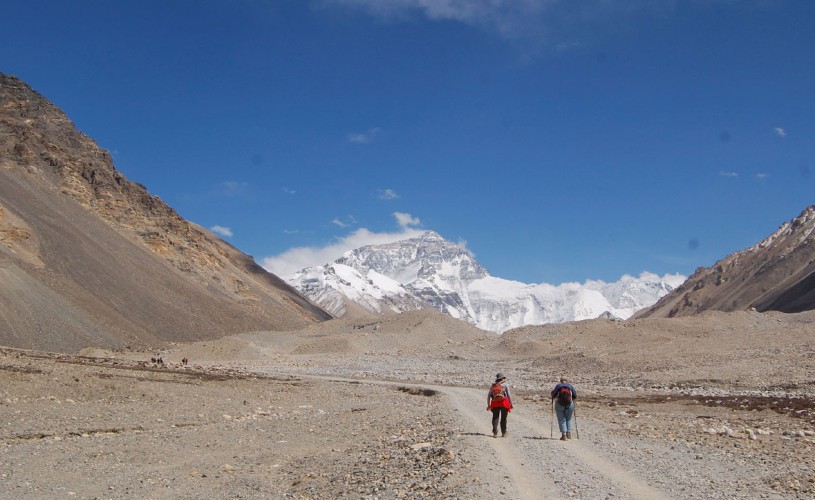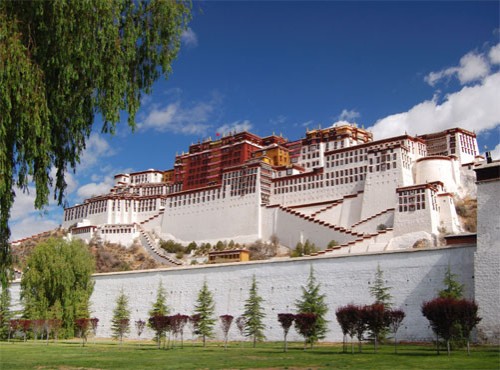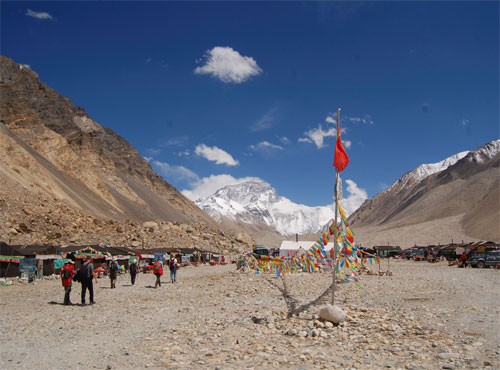Lhasa to Kathmandu Via EBC Tour Highlights:
- Stand at the base camp of the world’s highest mountain, Mt. Everest.
- Admire the breathtaking Rongbuk Glacier, a natural marvel.
- Enjoy stunning views of the Shishapangma and Cho Oyu peaks.
- Explore the beautiful and mystical Yamdrok Lake (Yamdrok Tso).
- Cross spectacular high mountain passes like Karo La, Khamba La, and Gyatso La.
- Visit iconic Tibetan landmarks such as the Potala Palace and Rongbuk Monastery.
- Immerse yourself in the serene beauty and rich culture of Tibet.
Lhasa to Kathmandu Overland Tour via EBC Overview:
The Lhasa-Kathmandu Overland Tour via Everest Base Camp starts in Lhasa and ends in Kathmandu. During the tour, we also visit other beautiful Tibetan towns and cities, such as Gyantse and Shigatse. On the seventh day of our journey, we reached the base camp for the world's tallest peak, Mt Everest. This Lhasa-Kathmandu Overland Tour with Everest Base Camp allows us to visit the Yamdrok Tso Lake and climb high passes like Karo La. Khamba La. Gyatso La. Lalung La. We can also see the Nazin Kang Sang Glacier. This tour takes us to famous Tibetan landmarks such as the Dalai Lama's Potala, Norbulingka Palaces, and Tibet Traditional Hospital. We also visit Barkhor Bazaar, Gyantse Dzong,Jokhang Temple, and Gyantse Dzong. We see several magnificent Tibetan monasteries, including but not limited to Sera, Drepung Phalkot Shalu Tashilhunpo Khumbum Stupa Sakya Rongbuk, the world's tallest monastery. This trip's highlights include reaching the base of Mt. Everest base camp, the Rongbuk Glacier, and the Shishapangma & Cho Oyu peaks.
The Lhasa-Kathmandu Overland Tour via Everest Base Camp takes you on an exotic journey through Tibet. You will enjoy the highland city and the unobstructed views of the mighty Everest (8.848m), also known as the roof of the World. Explore ancient cities with their historic monasteries and be fascinated by the views of the mighty peaks.
Lhasa is the cultural and historic heart of Tibet. It has a dense concentration of ancient monuments and cultural sites. We explore Potala Palace and Sera Monastery, Drepung Monastery, Barkhor Market, Jokhang Temple, and Norbulingka Palace. Before heading to Everest Base Camp, we explore the main sites of this medieval town. We can gain a deeper understanding of local cultures and acclimatize properly.
After Lhasa, we drive to Everest Base Camp via Gyantse or Shigatse, important cities in Tibet. We visit fascinating cultural sites such as Old Tingri and Pelkor Monastery. Rongbuk, Sakya, and Tashi Lhunpa are also included. The best way to experience the Tibetan landscape is by seeing the stunning glaciers and shimmering lakes. This is the most comprehensive tour in Tibet, and it includes all of the major landmarks on the route between Lhasa and Kathmandu.
Best Time for the Lhasa -Everest Base Camp Tour
The best time to visit Everest Base Camp via Lhasa is April to Jun and September to November. This is the best time to visit because it's warm and sunny, with little to no rain. The tour can be done in Winter, such as December, January, and February. However, it will be freezing. Temperatures drop to minus 15 degrees Celsius.
How is the food During the Tour?
On this trip, only breakfasts are provided. You'll need to pay for your lunches and dinners. Breakfast will be served where we stay overnight, and dinner arrangements can be similar. Lunch will be eaten while we're traveling to the next place. We suggest budgeting around Yuan 60 to Yuan 100 (US$10 to US$16) daily for lunch and dinner. Our meals will include Tibetan bread, dal (lentil soup), bhat (rice), tsampa porridge, and other essential local dishes.
Travel Documents Required for Entry to Tibet
Passport
All travelers must have a passport valid for at least 6 months.
Chinese Visa: This can be obtained from a Chinese Embassy or through China Highlights if entering Tibet from China.
Group Visa: Required for travelers entering Tibet from Nepal. After the Tibet tour, travelers can continue to mainland China with a valid group visa.
Note: An individual Chinese visa in your passport will be canceled if a group visa is issued.
Tibet Entry Permit
Issued by the Tibet Tourism Bureau, this is a mandatory document for all foreigners entering Tibet.
Additional Permits for Specific Areas
Travel Permit: Required for access to restricted areas within Tibet. This permit is issued after your arrival in Tibet.
Military Permit: Necessary for visiting certain militarily sensitive regions in Tibet. Ensure all required documents are in order before your trip to enjoy a smooth and hassle-free journey to Tibet.
Visa Process for Tibet Overland Tour from Nepal
According to the latest regulations from the Chinese Embassy in Nepal, a minimum of four people is required to apply for a Tibet group visa. The application process in Kathmandu involves submitting the original passport and typically takes 3–4 official working days to complete.
Please note that visa requirements and regulations are subject to frequent changes. We recommend confirming the latest requirements with Adventure Club Trek before booking your Tibet tour to ensure a smooth process.






